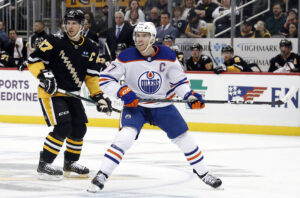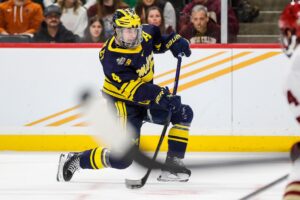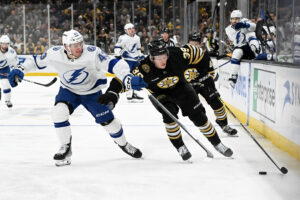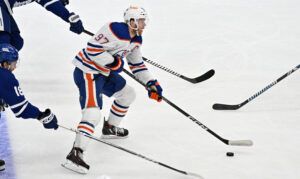The Franchise Best Series comes to you to dive into the all-time best single season for every organization. This, of course, includes post-season results. Join us for a look back at some of the most memorable moments in each franchise’s history. Here is the New York Rangers best season.
Franchise Best: New York Rangers 1993-94 Season
“This One Will Last a Lifetime!”
A chill runs up my spine when I hear Sam Rosen utter those iconic words. As the legendary New York Rangers captain Mark Messier hoisted the Stanley Cup for the first time in 54 years, Madison Square Garden felt a little closer to heaven. However, heaven couldn’t have felt farther away only a year prior.
The Collapse of 1992-93
After earning the President’s Trophy during the 1991-92 season, the New York Rangers were on the road to success. Fans were optimistic, and a plethora of core players remained in the line up. Finishing last place in the Patrick Division would have been a laughable hypothesis in October 1992. However, the Rangers’ slow start and inability to replicate the previous season’s success put the team exactly there—last. Their hall of fame coach, Roger Neilson, who couldn’t gel with Messier, along with several unprecedented injuries, were the main cruxes behind the Rangers embarrassing early 90s performance.
After winning a mediocre 19 of their first 40 games, Neilson was replaced by Ron Smith. The demise of Neilson surprised Rangerstown, as Neilson had led the team to two first-place finishes and one second-place finish since his first season coaching the team in 1989-90. In fact, the Rangers hadn’t earned any sort of title since 1941-42. The unfortunate reality was that Neilson had lost the room. As the team turned south, Messier pointed the finger at Neilson, and Neilson pointed it right back. Neilson maintained that Messier’s strong leadership had wavered in the face of adversity. Messier consistently expressed his disdain for Neilson’s frantic line changes and shifts of personnel, which caused a lack of chemistry within the team. True to form, the Rangers players stuck by their captain despite Neilson’s gripes.
“Let’s face it, this whole team changed. It’s unfair to put Mark on the spot because he’s the captain and he’s the one with all the weight on his shoulders. We weren’t doing our jobs,” said forward Doug Weight in a January 1993 New York Times article.
Messier was quick to praise Smith, the replacement coach, continuing to fuel the fire between Neilson and the Broadway star. However, despite the early accolades, Smith would do no better at regaining the Rangers’ former glory. Their record continued to suffer, ending the season with seven straight losses on home ice. In their last 12 match-ups, they only won a single game.
Men Down
Amidst the increasingly tense climate in the Pennsylvania Plaza locker room, the Rangers were also plagued by a multitude of injuries. The most damaging came to Brian Leetch, the integral defenseman. Leetch glittered in 1991-92 with a career-best 102 points. He earned him the Norris Trophy. Leetch is also the last defenseman to score 100 points in a season. The Rangers fed off his success and when it was taken away, the team suffered. Leetch missed 48 of 84 games, 34 due to a compressed nerve suffered in mid-December. After briefly returning, a cruel twist of fate struck the Blueshirts. Leetch slipped on the sidewalk outside his Manhattan home and broke his right ankle, sidelining him for the remainder of the season. During Leetch’s absence, the Rangers were 14-26-8. With him, they were 20-13-3.
In addition to Leetch’s excruciating exit, the Rangers lost Messier for nine games, and center Darren Turcotte for 13 games with a broken foot. Defenseman James Patrick also missed the final 10 tilts of the season with a herniated disk in his back.
Chants of “1940” rang out in the Garden as the Rangers closed the book on a “wasted season,” leaving behind a fan base who didn’t believe they would ever see Lord Stanley return to Manhattan.
A New Day, A New Coach
Only 24 hours after the Rangers ended their season in April 1993, Smith was out. GM Neil Smith announced that Mike Keenan would be the head coach. Keenan had a reputation as a disciplinarian, nicknamed “Iron Mike” by his players. If there was something this Rangers team needed, it was an iron fist to knock them back into shape. Keenan was the first ingredient in the Rangers winning formula. He had previously coached the Philadelphia Flyers and fellow original six team, the Chicago Blackhawks. According to Smith, Keenan was the only man for the job. Swiftly hiring Keenan ensured that he wouldn’t take the coaching offer from the Flyers, whom he’d led to two Stanley Cup Finals in the 80s. Keenan was a worthy antidote for a season the Rangers, and everyone associated with them wanted to forget.
Off-Season Additions
Considering how different 92-93 and 93-94 were, it’s hard to believe that the core of the Rangers team stayed the same in the off-season. However, an important moment in NHL history occurred that would solidify the Rangers number one netminder: the expansion draft of the Florida Panthers and Mighty Ducks of Anaheim. The Rangers were forced to protect either Mike Richter or John Vanbiesbrouck. Vanbiesbrouck was then traded to Vancouver in exchange for defenseman Doug Lidster. Richter was now the man between the pipes but many were haunted by the center ice goal Richter let in during game five against the Pittsburgh Penguins the season prior. Fortunately for the Rangers, Richter rose to the occasion, finishing the regular season with a record of 42-12-6. To this day, he is regarded as one of the best goaltenders in Rangers history.
Even though Richter was confidently in first place, every goalie needs a good backup. The Rangers acquired Glenn Healy from the Tampa Bay Lightning as a 1993 third round pick. He appeared in 29 games and emerged with a 10-12-2 record. Greg Gilbert was also added in the off-season from Chicago. He earned 15 points on the season.
Key Storylines Throughout The Year
The New Reign Begins
As soon as the season began, Keenan made his strict intentions with the Rangers very clear. His system was rigid. Two-a-day scrimmages were something of a norm with Keenan. If a player wasn’t performing his best, he was benched.
“They have to learn the difference between being an average performer and being a top performer,” Keenan said. “It’s better to find out who can handle these situations in October than in the springtime.”
After starting 4-5-0 in the first nine games, Keenan thought it would take until Christmas for the Blueshirts to get used to his style. However, by mid-November the Blueshirts were lighting up the scoreboard, elevating their record to 12-5-2 with the best penalty kill percentage in the league and nine shorthanded goals.
As the All-Star break arrived the Blueshirts were number one in the league with 63 points. Not only that but they boasted the best winning percentage, they were first in penalty killing, had the most shorthanded goals and the best GAA. Iron Mike was more than pleased. Securely in first place, sentiments were shifting about the Rangers chance at success.
Built like Bulls and Bears
Not only were the Rangers hitting the net at an impressive pace, they were also one of the strongest teams to hit the ice. Massive players like Jeff Beukeboom, Jay Wells, Joey Kocur and Messier added a palpable element of fear as their opponents hit the ice. Additionally, the top line of consisted of Messier centring star players like Adam Graves, Leetch and Sergei Zubov. Moving into the postseason, many considered the Rangers to have the most feared attack in the NHL.
Top Scorers
Among the many players who contributed to 1993-94’s success, four stood out among the rest: Zubov (89 points), Messier (84 points), Graves (79 points) and Leetch (79 points). Zubov was the first defenseman to earn top scoring honours with his 77 assists and 12 goals. Messier has 26 goals and 58 assists. Graves tallied a whopping 52 goals and 27 assists. Leetch performed extremely well after a previous season wrought with injuries, regaining his reputation for excellence. He earned 23 goals and 56 assists. Leetch would only elevate his game heading into the postseason, adding more hardware to his growing collection.
In-Season Additions
Throughout the season, it is important to maintain chemistry within a locker room, especially if the team is performing well. The Rangers largely stuck with their starting roster but brought a few new faces who could mesh well with Keenan’s coaching style.
In November, Patrick and Turcotte proved unable to adapt to the new coach’s method. Steve Larmer and Nick Kypreos arrived in their spots as part of the three-way deal. At the trade deadline, Craig MacTavish, Glenn Anderson, Brian Noonan and Stephane Matteau came to New York. If you find one of those names stands out from the others, you are right.
Matteau, who arrived from Chicago, is responsible for one of the most iconic moments in Rangers history. “Matteau, Matteau, Matteau!” echoed as Matteau scored the wrap around game-winning goal to send the Rangers to the Stanley Cup Final. The New Jersey Devils were eliminated and Messier’s guarantee was granted.
Playoff Performers
Those coveted sixteen games couldn’t have been won if it wasn’t for the supreme efforts of Leetch (34 points), Messier (30 points), Alex Kovalev (21 points) and Zubov (19 points). Leetch went on to earn the scoring title and become the first American-born player to win the Conn Smythe Trophy. His magical play to was essential in the Rangers Stanley Cup journey. According to goaltender Richter, Leetch was at his best every shift. He was dominant in all three zones of play, a priceless asset to a winning hockey team.
Mike Richter established himself as a big game goalie in the ’94 playoffs. He posted a 16-7 record with a 2.09 goals against average and a .921 save percentage. IN one of the more memorable Stanley Cup moments, Richter stopped Pavel Bure on a penalty shot in game four of the final.
Messier’s confidence in his team gave the Rangers that extra confidence they needed to achieve championship greatness. He gave his now iconic guarantee and then backed up his own words. Messier scored twice to eliminate New Jersey’s 2-1 lead in the third period. He then completed a natural hat trick on an empty-net to give the Rangers a 4-2 win. Hello Captain Clutch, thank you very much.
Kovalev’s stickhandling skills and dominant wristers put him third for most points in the 93-94 playoffs. He, along with Alexander Karpovtsev, Sergei Nemchinov, and Zubov, became the first Russians to have their names engraved on the Stanley Cup. Zubov, the points leader in the regular season, also continued to contribute with 5 goals and 14 assists in his first-ever NHL playoffs.
End Result
There was a resounding positivity surrounding the Rangers heading into the playoffs. While no one, except for Messier, was making guarantees, the Rangers had a phenomenal season that positioned them well for post-season success. A strong core of players with years of chemistry, a number one goaltender playing at his prime and a coach who gave no mercy all added up to sixteen glorious wins for the Blueshirts. The generations of painful waiting had ended. The New York Rangers won the Stanley Cup on June 14, 1994, in game seven against the Vancouver Canucks, with a final tally of 3-2.
“We couldn’t wait to get on the bus in our Rangers jerseys the day after they won the cup so we could chant “1994,” said Bill Faughnan, a senior in High School at the time of the win.
At long last, the ruthless chants of “1940” were over. Lifelong fans could die in peace.
Embed from Getty Images






